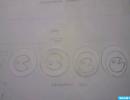Triangular kusudama. Origami kusudama: original techniques for beginners. Kusudama assembly diagrams
Kusudama- an origami technique that allows you to create beautiful 3D models of flowers by gluing different parts, rather than folding one into one as is used in most origami crafts. Today, we will learn how to make a flower using this method, and also show you many options various crafts which you can do if you know kusudama.
How to make a kusudama flower?
To create one color using this technology, we will use:
Five square sheets
. PVA glue
. paper clip
Let's get started creating right away!
1. Take a sheet of paper and place one end of it towards you.
2. We bend the bottom corner to the top corner so that we get a triangle with two equal sides.

3. The left and right corners should be bent towards the apex of the triangle. And we get a square again.

4. The sides bent towards the top need to be folded in half outwards, as shown in the photo.

5. The inner parts of the left and right bent parts need to be turned outward.

6. We turn our workpiece over.

7. As you can see, the left and right parts of the inverted triangles stick out a little, we need to remove them by wrapping them in the middle. First we bend the left side, then the right.


8. We turn the workpiece over again.

9. Fold the left and right corners towards the middle, exactly along the resulting line.

10. On one bent side, with outside, spread glue.

11 . We connect the two extreme sides and secure them with a paper clip until the glue dries.

12. So we made one of five blanks for the flower. We also make 4 more blanks. We can alternate colors.

13. To make a flower from the five resulting blanks, smear the central seam with glue and connect them one after another.

14. To prevent our flower from falling apart before the glue has dried, it is better to secure the blanks with paper clips.

15. When the glue dries, we can remove the paper clips and see our result.

Kusudama is a Japanese paper craft created from several identical origami figures glued together. Traditionally, origami kusudama was used as a ball for storing incense or aromatic mixtures of dried petals, but today it is more of a decorative item, original gift and just an interesting, unusual decoration.


How to make kusudama from paper: easy and simple!
Now you will learn how to make kusudama from paper. There are many schemes by which kusudama flowers can be easily and simply made; we tried to select the most basic ones, but which give an excellent result. They are perfectly mastered even by beginners and allow you to create real miracles from ordinary scrap materials.
 Each of our readers can create such a flower arrangement!
Each of our readers can create such a flower arrangement!
Everything you need for an origami masterpiece:
- 60 paper squares measuring 7x7cm;
- PVA glue (or glue stick).
Below we will demonstrate how to make the basic (basic) flower shape. Please note that this scheme flower kusudama is universal, that is, all the following manipulations must be done with all your paper squares. As a result, you will get 12 kusudama flowers, consisting of 5 such shapes. In our next instructions, we will explain how to correctly form and glue all the flowers, giving the structure the shape of a ball.
Simple kusudama for beginners - assembly diagram
An exclusive author's postcard or a romantic message can be made from multi-colored paper using the origami technique. Even a single kusudama flower can become beautiful decoration, a decorative element that newlyweds can use to decorate wedding invitations, breaking the stereotypical idea of familiar things. It looks absolutely amazing!
We present to your attention the simplest kusudama for beginners, which will help you master the technique and develop the skill of making kusudama flowers.





Please note: the “front fold” allows you to make 3 petals inside the main petal. If you fold the top corners back, as shown in the picture below, you will end up with only one petal inside the larger petal.



- Fold the paper square in half to form a neat triangle. Precision of movements is the key to excellent results, so don’t rush!
- Fold the left and right corners of the resulting triangle towards the top to form a diamond.
- Fold the resulting triangular “flaps” in half, as shown in the figure.
- Open the flaps and smooth them out.
- Fold the upper corners of the kusudama flaps towards themselves so that they are flush with the edges of the paper.
- Next, fold the triangles back along the fold that was made before and glue the outer triangles together.
- Now make 5 petals and glue them together in a circle to make a flower. Take your time, let the glue “grab” well. If you did everything correctly, your cinquefoil will look like the one in the picture below.
Well, our flower kusudama is ready!
Start learning to do better simple kusudama- models consisting of a small number of modules. Quick success will delight you and inspire you to take on more complex projects. WomanOnly has collected simple kusudama patterns for you. Choose thick paper and go for it!
Classic kusudama
The simplest kusudama consists of 6 modules and is shaped more like a cube. Almost all beginning amateurs first perform this classic kusudama. You will need 6 identical squares. Despite its simplicity, this kusudama looks very elegant due to the sharp petals. Try to bend the paper as clearly as possible so that the kusudama does not come out askew.
The modules of this kusudama are glued together with glue. You can insert a loop of thread or ribbon into one of the gluing points for hanging.

Cube without corners
Simple kusudama “Cube without corners” done very quickly. It also consists of 6 simple modules, each of which, in turn, consists of 4 simpler elements. To get two-color pattern, you will need 2 colors of paper or double-sided colored paper.


Cube Can be hung from glued loop or just put it on the table.
It turns out? Now you can try something more complicated.
Cookie cutters
Surely you also had or have star-shaped cookie cutters. This is exactly what the next simple kusudama will look like. It will take a little more time to complete. You need to assemble 30 simple modules and glue them together. For convenience, cut 30 identical 7 x 7 cm squares in advance.
The ends of the finished modules need to be inserted into each other and secured with glue. Ready-made kusudama “Cookie cutters” can become a beautiful flashlight, throwing stars onto the walls.


By the way, if you take not 30, but 90 modules, arm yourself with patience and ingenuity, you can make a huge ball with star-shaped holes. The main thing is not to stop there!
Bells
For those who are missing stars from the sky but enjoy the flowers of the earth, we have prepared simple diagram kusudama"Bells" This floral kusudama looks equally beautiful even if it is made from magazine paper.
To make kusudama “Bells” you will need to make 12 flowers, each of which consists of 5 petals. That is, the entire kusudama consists of 60 identical petal modules. Prepare 60 identical squares. Select the size of the square based on the desired size of the kusudama: the diameter of the finished kusudama will be equal to the diagonal of the square.
When you are done with the petals, glue them together in groups of 5 on the inner short side. Then glue together 3 flowers, 6 flowers. Before completing the work, glue a hanging loop into the center of the ball; you can decorate the kusudama below brush or beads.
It will not be at all difficult to assemble this simple kusudama with our

One of the most pleasant chores is decorating the house for the New Year. In this business, you always want variety, to find and try something new. An excellent solution would be kusudama balls - “medicine ball”, if translated literally. Kusudama - creation modular origami, whose history goes deep into the past.
Once upon a time in Japan, collected flowers and plants, sometimes incense, were placed in such balls. A lot of time has passed and now these crafts are used as gifts or decorations. They are made from paper by folding modules and then connecting them.
To make a standard paper ball you will need:
- paper;
- scissors or knife;
- glue;
- threads
Although more modern masters are also inventing types of kusudama that do not require cutting or gluing, and threads are required exclusively for hanging. The simplest and most New Year's kusudama is “Icicles”. You can choose paper with glitter for it, then finished product It will shine and sparkle in the sun’s rays - just like real ice!




The option is a little more complicated - “Blooming icicles”. The beginning of the folding of the modules is exactly the same, but at the final stage in this version they are given greater openness. A very beautiful and lively decoration option! You can also choose a suitable pendant to match the colors of the paper and attach it to one of the ends - this will visually lengthen the ball and add new colors. 

A more “twisted” model “Star of Talit”. Making such a kusudama is not as easy as the previous ones - to fold one part, it will take as many as fourteen steps. But “Star” looks brighter and reveals a real master in its author.



If you like the idea of making paper balls for the Christmas tree, but don’t have much time, “Karl’s Mandala” may be a way out of the situation. Unlike previous models, which require thirty components, “Mandala” is assembled from only eight. In addition, they are completely easy to fold and connect. The product looks more pointed, which gives it a certain charm.
Another option of thirty modules is “Little Roses”. If you choose warm-colored paper for them, you can end up with a very delicate and cute decoration. This “rose” will be an ideal decoration for New Year's decorations in the apartment of a couple in love!


For those who like bright and stylish things, you can try making a “Small Island”. It will also require folding thirty blanks, but the result of the assembly will seem like a reflection of creativity, especially if you choose restless colors. A great option for young people.


Kusudama “Clover” will require some endurance and perseverance when folding. However, the efforts will not be wasted - such a ball looks incredibly beautiful and technologically advanced.



The “Little Roses” mentioned above can be made more realistic, with curled corners. This variation is more like flowering plant. Its difference is in the blanks for the modules - at that time they were rectangles, but here squares are used. A good idea would be to make “Roses” in both techniques, and alternate them when hanging.


Looking at an apartment decorated for the holiday is nice, but it’s much nicer to know that the decorations were made by yourself. The art of origami - like any art - can give this joy. The Kusudama balls you make can be given to friends and family to convey to them a piece of your joy and holiday atmosphere!
Japanese origami has long been popular among the population. different countries. This technique allows you to create stunning masterpieces from simple paper. Moreover, it is not so difficult to master; almost anyone can make simple fakes. One of the directions is spherical models, which are assembled by gluing together different figures. This technique is called kusudama. For beginners it is perfect.
Kusudama appeared in Japan many centuries ago; even during the times of serving the cult of the Sun, it was used in various rituals. The sun was depicted with red clove balls with medicinal herbs inside (“kusuri” translated as medicine), which were hung on the four cardinal points. This tradition continues to this day, and kusudama can be seen at every Japanese holiday.
But there is another theory of the origin of this word, but it is also connected with medicinal properties. Previously, the healing fruits of the camphor tree (“kusu” in translation means camphor) were put into fakes and placed in the room in order to free it from harmful microorganisms and disinfect the room as a whole. It was believed that the aroma of camphor could heal the human body and soul.
But, no matter where the story begins, in any case it is connected with treatment, which means it will be useful to know how to make kusudama yourself.
Preparing for work
Before you start creating a masterpiece, you need to take care of the set necessary tools and materials. As is already clear, the most important step is the selection of paper.

It can be absolutely anything; moreover, at the very beginning it is best to experiment on ordinary colored paper, which children work with in creative classes.
After the technique has been more or less mastered, you can look for a professional base in city stores or use glossy pages, they will give the future ball individuality.
Of course, you also cannot do without sharp and adhesive objects, as well as decor. Required:
- scissors;
- PVA glue;
- a spool of thread of a matching or contrasting color;
- needles;
- beads, ribbons, sequins, buttons, etc.
 By the time you prepare the material, you should already have an idea for the future product; you can search for kusudama diagrams in pictures for beginners using the Internet or books. Most often, balls are assembled from separately made various modules, for example, bells, lilies, roses, and sakura flowers.
By the time you prepare the material, you should already have an idea for the future product; you can search for kusudama diagrams in pictures for beginners using the Internet or books. Most often, balls are assembled from separately made various modules, for example, bells, lilies, roses, and sakura flowers.
If you have absolutely no ideas, then you can use the classic scheme, which has been known for many years.
Classic version of the product
To make a classic kusudama ball pattern for beginners, you will need 24 sheets with equal sides, in other words, squares of paper. They can be either the same color or contrasting. You also need the tools listed above. Assembling a magic product step by step begins with folding the component parts or modules. To do this:
- Take one square and fold it in half diagonally to end up with a triangle. Its sharp corners are bent into the center so that the end result is a square again.
- Next, the folded corners are folded into reverse side from the center, while maintaining its shape.
- Using your finger, straighten the resulting triangles on the sides so that the center line of each is extended to the surface.
- The protruding parts of the triangles are bent towards the center from the top to the sides so that the lower part again takes the shape of a square, after which there should be two wings on both sides. Glue is applied to one of them and the figure is fastened in a semicircle using paper clips or a clothespin. Another 24 elements are made in the same way. In the photo the diagram looks like this.

After each petal is ready and the glue is dried, the origami flowers are collected. They consist of 4 modules, but you can use more if you want the figure to be more voluminous.
At the final stage you should get 6 flowers, which connect with each other. Four in a circle, and the fifth and sixth from above and below. The classic version is ready. Of course, you can also decorate the ball with decorations, if you so desire.
Usually, when getting acquainted with the technique, they start with the classic kusudama patterns for beginners, because they are the easiest to understand.
But this does not mean at all that they are less beautiful, so you should not immediately pursue complex options, but rather pay attention to simple products.
Master class balloon Butterfly
Another good and simple version of the kusudama ball pattern made from paper for beginners is the butterfly. It is very beautiful and is said to bring happiness to its owners. From classic version differs in that in this case you will need not squares, but rectangles, and the smaller side should have a ratio of 1:2 to the larger one. For a more original performance, it is better to use in equal parts plain paper and corrugated. Thus, you need to prepare 30 sheets of each. Start with a strip of plain paper:
- An even rectangle is folded in half, then unbent and the upper left and lower left corners are folded towards the center.
- Next, the corners are folded again towards the center so that the result is a rhombus.
- Free opposite corners are folded in half. The resulting rhombus is folded in half into a triangle, after which the product is returned to its original state and we proceed to work with corrugation.
- The sheet is folded in half with the wavy side inward. Next, the two sides are bent to the middle, two rectangles should be visible from above and one from the bottom in the center. The lower right and upper left corners are folded evenly.
- Now we start assembling the module. Place the second one in the center on the first piece and fold the lower part along pre-marked lines to secure the corrugation.
- Before the last addition into a triangle on corrugated paper Apply glue and fix until dry. We can assume that the first module is ready; the remaining thirty pieces are also added.
- The last step, as always, is general assembly. All steps can be seen in more detail in the image.

The main thing is not to forget to glue the tape or thread in the center if you plan to hang the figure. Additionally, the butterfly can be decorated with rhinestones and sequins, but you don’t need to get too carried away, because the resulting masterpiece already looks wonderful.
Origami kusudama is a rather interesting hobby that can be mastered with children, and the ball patterns presented on the Internet will help you acquire a new hobby on your own and easily.






